SRINAGAR: With all communications blocked and the entire erstwhile state of Jammu and Kashmir under lock and key, the Home Minister Amit Shah announced the abrogation of Article 370 and reorganization of Jammu and Kashmir into two Union Territories on August 5, 2019. The Himalayan intervention was hugely commented upon in the newspapers the next date. Kashmir had no access to information.
A year later, we are reproducing some of the editorials that appeared in the major newspapers being published in Delhi and other parts of India.
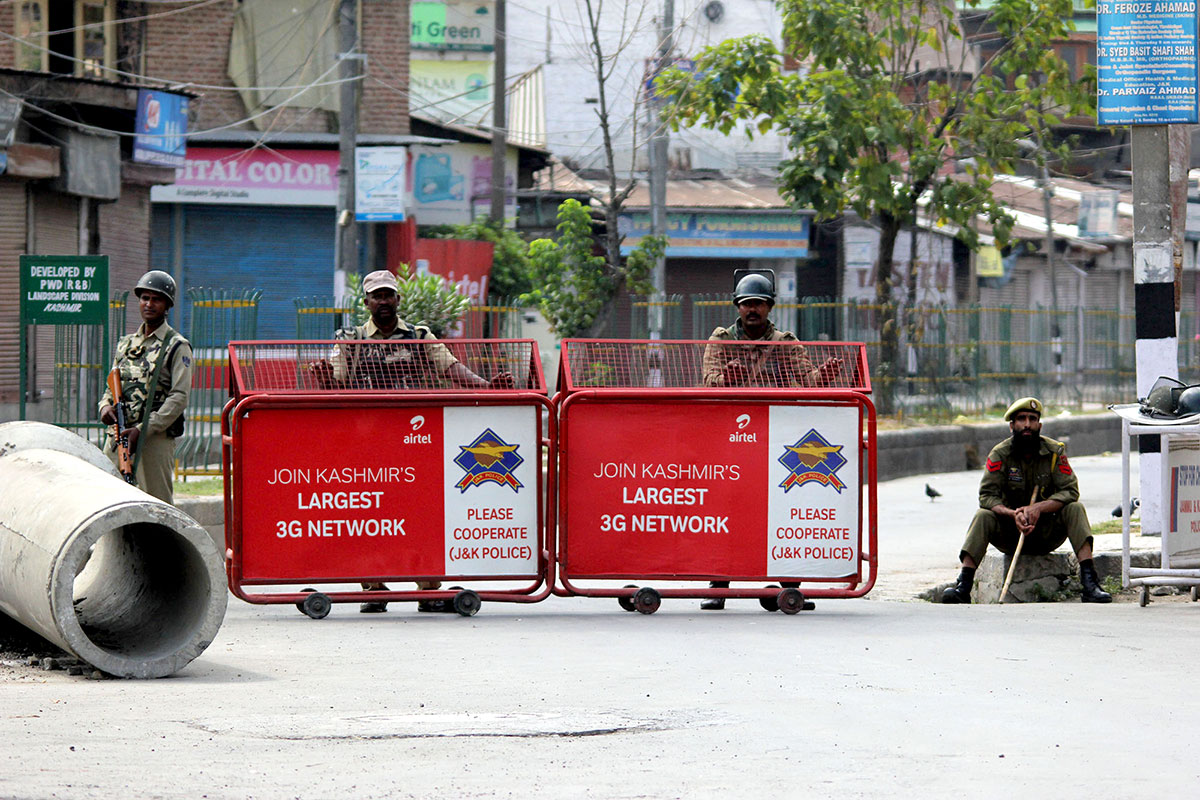
State of restrictions in Kashmir on October 1, 2019
Scrapping J&K’s Special Status Is The Wrong Way To An End
The special status of J&K was never meant to be permanent, but it should not have been scrapped without wider consultations
The Hindu, Chennai
August 6, 2019
Jammu and Kashmir has been a theatre of muscular Hindutva nationalism, in the early decades in script and since 2014 in performance. Adopting a highly militarist approach to separatism, and shunning political process entirely since 2014, the BJP has now delivered on a promise it has long made, by abrogating the special status that Jammu and Kashmir had enjoyed in the Constitution through a combination of executive and parliamentary measures. Additionally, the State is being downgraded and divided into two Union Territories. The mechanism that the government used to railroad its rigid ideological position on Jammu and Kashmir through the Rajya Sabha was both hasty and stealthy. This move will strain India’s social fabric not only in its impact on Jammu and Kashmir but also in the portents it holds for federalism, parliamentary democracy and diversity. The BJP-led government has undermined parliamentary authority in multiple ways since 2014, but the passing of legislation as far-reaching as dismembering a State without prior consultations has set a new low. The founding fathers of the Republic favoured a strong Centre, but they were also prudent in seeking the route of persuasion and accommodation towards linguistic and religious minorities in the interest of national integration. The centralising tendencies increased in the following decades, but Hindu nationalists always argued for stronger unitary provisions and viewed all particular aspirations with suspicion. For them, Jammu and Kashmir’s special constitutional status was an impediment, not an instrument, for the region’s integration with the rest of the country.
The entire exercise of getting Article 370 of the Constitution effectively abrogated has been marked by executive excess. The first step was to declare by a presidential decree that the ‘Governor’ — without regard to the fact that he has no Council of Ministers now to aid and advise him — can speak for the State government and give his concurrence to any modification in the way the Constitution of India applies to Jammu and Kashmir. Second, on the basis of this ‘concurrence’, the latest Presidential Order scraps the previous one of 1954, abrogating the separate Constitution of Jammu and Kashmir. Third, the fact that the State is under President’s Rule has been used to usher in a new dispensation under which Jammu and Kashmir becomes a Union Territory with a legislature and Ladakh another such territory without a legislature. In sum, a purported process to change the constitutional status of a sensitive border State has been achieved without any legislative input or representative contribution from its people. The bifurcation of States in the past cannot be cited as a binding precedent as, under Article 3 of the Constitution, the President seeks the views of the legislature of the States concerned, even if concurrence is not mandatory. In the present scenario, J&K has been represented by an unelected Governor appointed by the Centre, while Parliament has ventured to ratify the conversion of a State into two Union Territories without any recommendation from the State.
If there is a legal challenge to these measures, it would centre around whether such far-reaching steps could be achieved in the absence of a representative government by assuming that its gubernatorial administrator is constitutionally capable of using his consent as that of the entire State. Further, there is a self-enabling aspect to the Presidential Order. It performs a hop-step-and-jump feat. It hops over the requirement of the State government’s consent by declaring that the Governor is the State government. It steps over the need for aid and advice by the ministerial council by saying the Governor’s opinion is enough. And it jumps over the fact that there is no constituent assembly now by merely reading the term as ‘legislative assembly’, and letting Parliament perform the role of the State legislature. Thus the President’s power under Article 370 has been used both to create an enabling provision and to exercise it immediately to modify the Order, thereby dispensing with the role envisaged for the State Assembly. While it is true that in 1961 the Supreme Court upheld the President’s power to ‘modify’ the constitutional provisions in applying them to J&K, it is a moot question whether this can be invoked to make such a radical change: a functioning State has now been downgraded and bifurcated into two Union Territories. It is inconceivable that any State legislature would ever have recommended its own demotion in status.
True, the special status of J&K was meant to end, but only with the concurrence of its people. The Centre’s abrupt move disenfranchised them on a matter that directly affected their life and sentiments. Moreover, that this was done after a massive military build-up and the house arrest of senior political leaders, and the communications shutdown reveals a cynical disregard of democratic norms. It appears that the current government values J&K for its demonstrative impact before the rest of the country, as a place where a strong nation and its strong leader show uncompromising political will. But that may have other unintended consequences. Geographically and metaphorically, Jammu and Kashmir is the crown of secular India — a Muslim majority region in a Hindu majority country. Its people and leaders had chosen secular India over Islamic Pakistan, a fact that Islamists never reconciled with. The BJP’s adventurous route also has as backdrop an impending U.S. withdrawal from Afghanistan that will trigger an unforeseeable churn in Islamist politics in the region. Islamists have always viewed Kashmir as a component of their global grievances. Whatever its intent in enabling the full integration of Jammu and Kashmir with India, Monday’s decision to alter the State’s status could have unintended and dangerous consequences.
Rupture In History, Stitching A Future
Historic changes draw an audacious red line across Jammu and Kashmir and its compact with the Union. How government carries this forward will decide many things for India.
The Indian Express, Delhi
August 6, 2019
The NDA government’s decision to abrogate the special status to Jammu and Kashmir under Article 370 fulfills a nearly 70-year-old project of Hindutva parties, their promise that they would one day make the “integration” of J&K with the Union of India a reality. The Constitution (Application to Jammu & Kashmir) Order 2019 supersedes the 1954 order, which included Article 35 A, and defined the state’s special status. Article 35 A has ceased to exist. Although Article 370 remains, it’s effectively dead. The government has simultaneously proposed the bifurcation of the state through the Jammu & Kashmir State Reorganisation Bill 2019, under which it will become two Union Territories, one comprising Ladakh without a legislature, another comprising Jammu & Kashmir, with a legislature.
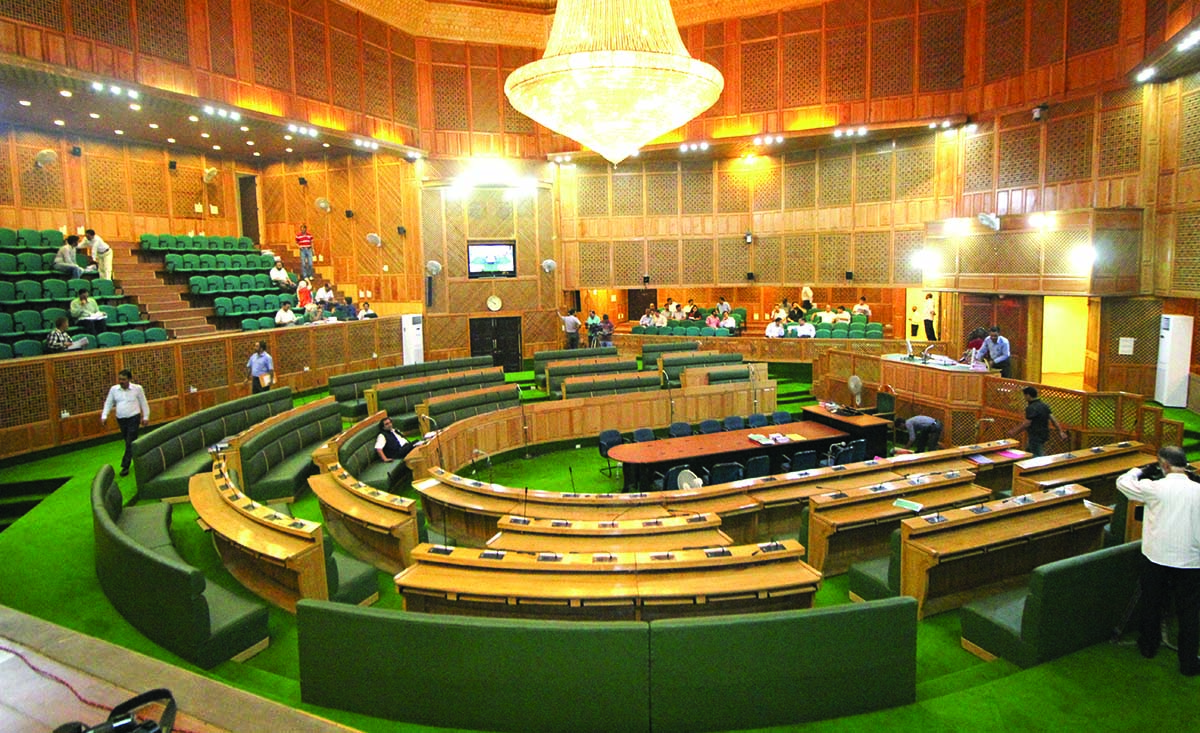
A rare click in the assembly showing Sajjad Gani Lone as the only lawmaker present in the house in late 2017. That day, he was slightly earlier than all others. KL Image: Bilal Bahadur
But the special status guaranteed to Jammu and Kashmir was not a partisan or personal decision of the founding fathers of the Indian republic. It was based in the imperative of nation-building. It was a recognition of the role a Muslim majority state — its unique demography protected by the Constitution — would play in belying the claims on which Partition had taken place, and in strengthening the secular “idea of India”. The developments of August 5, 2019, are in no small measure about rewriting history, changing that very demography, and bringing in a new idea of India, with the stamp of Narendra Modi firmly on it. The changes are no less than historic, they draw an audacious red line over and across the Nehruvian idea of India.
But what is this new idea of India, and how will it be given shape? What will also go down in history is the manner in which the momentous change in J&K’s status has been brought about. There is no parallel in the history of independent India for the secrecy and stealth deployed by the government to bring in something that is politically and communally contentious. To do this at a time when Parliament is in session, to present it as a virtual fait accompli to the House, may be the BJP’s way of doing business, as it believes it has the mandate. But it goes against every democratic convention and norm.
Curiously, government officials put out the red herring of a purported terror plot emanating from Pakistan to justify the induction of additional troops in the Valley and cancellation of the Amarnath Yatra. As it has turned out, these were law and order measures in anticipation of a backlash to the government’s real plans. For the first time since the 1953 arrest of Sheikh Abdullah, the government placed two former chief ministers, both leaders of mainstream political parties, under arrest.
The promise of resolving the Kashmir issue through partnership and dialogue with Kashmiris, articulated by a BJP prime minister, Atal Bihari Vajpayee, and carried forward by a Congress prime minister, Manmohan Singh, was implicit in the PDP-BJP alliance of 2015-2018. It failed, yet as recently as last year, Prime Minister Modi invoked Vajpayee’s “insaaniyat, jahmuriyat, Kashmiriyat” credo for resolution in Kashmir. It now seems that he and his trusted lieutenant believe that the people of Kashmir need not be consulted at all about their political fate, and that the use of force can overcome their opposition.
Now that the die has been cast, how the government proposes to carry this forward from here, how it will deal with the legal and political fallout and the reactions in the Valley, will decide many things for India. If the unkept promise of autonomy in Article 370 was the genesis of the Kashmir problem, the government has significantly departed from that, not just by its definitive move to scrap the constitutional guarantee of that autonomy but by demoting the state into truncated union territories that will now be governed directly by the Union home ministry through an all powerful Lt. Governor, working with an emasculated legislature.
Regional parties, such as AIADMK and TRS, that have supported the government’s move, might do well to ask themselves what they would do if the Centre decided that Tamil Nadu, with a traditionally strong regional ethos, be carved up into union territories. But the challenge for the Opposition is also more than a distant thought experiment. It is real and it is already here: A BJP that is bringing its “core issues” — for long relegated to the backburner — to centrestage. A BJP with a mandate that will have its way, few questions asked.
It cannot be the government’s intention to keep voices in the Valley suppressed forever. For starters, it must release Omar Abdullah, Mehbooba Mufti and Sajjad Lone, leaders with a following in the Valley and in Jammu too. It must remove restrictions on movement in the Valley, allow telecommunications to be restarted. It must demonstrate that its political confidence to do what it has done in Kashmir does not flow out of the barrel of a gun or a numerical majority alone. There will be other challenges, such as the changing dynamics in the region, especially the deal with Pakistan’s help, in Afghanistan between the US and Taliban. This is hard work in progress even though the deed has been done.
Support on Kashmir: Nationalism Continues To Be The Ace Up The BJP’s Sleeve
The BJP must reaffirm its commitment to the compact between the State and the people of Jammu and Kashmir
The Telegraph, Kolkata
August 7, 2019
The neutering of the special status of Jammu and Kashmir enshrined in Article 370 along with the bifurcation of the state into two separate Union territories — the Jammu and Kashmir state reorganisation bill, 2019, has taken care of this goal — by the Bharatiya Janata Party-led government at the Centre should not necessarily be seen as a radical departure. Kashmir’s ‘autonomy’, a sensitive issue for some constituencies in the state, has been a matter of conjecture for long. Several constitutional provisions, Articles 356, 357 and 249 — the last gave the Centre the right to legislate on issues on the provincial list — had been applied to the state incrementally. The BJP’s decision to do away with Kashmir’s ‘privileges’ — they were more symbolic than substantial — therefore, must be seen in the context of this history of not-so-infrequent interventions. What, however, is novel is the scale of the public support for the measure. The collective endorsement for the transformation in Jammu and Kashmir’s status is unprecedented. That perhaps explains the rather feeble attempt by the Opposition to thwart the measure that is said to have been honed by the Union home minister, Amit Shah. The Aam Aadmi Party, which has been a vocal critic of the BJP’s supposed lack of respect for federalism, supported the resolution, as did the Bahujan Samaj Party, the Biju Janata Dal, the Telugu Desam Party, among others. The Congress and the Left voted against the bill but the Trinamul Congress, the BJP’s principal opponent in Bengal, staged a walk-out during the voting. The support from some unexpected quarters and the diffidence of some opponents prove that the rhetoric of nationalism continues to be the ace up the BJP’s sleeve. Public approval for the BJP’s idea of nationalism has led to the nation viewing older emblems of accommodation — Kashmir’s accession to India being one — with marked circumspection.
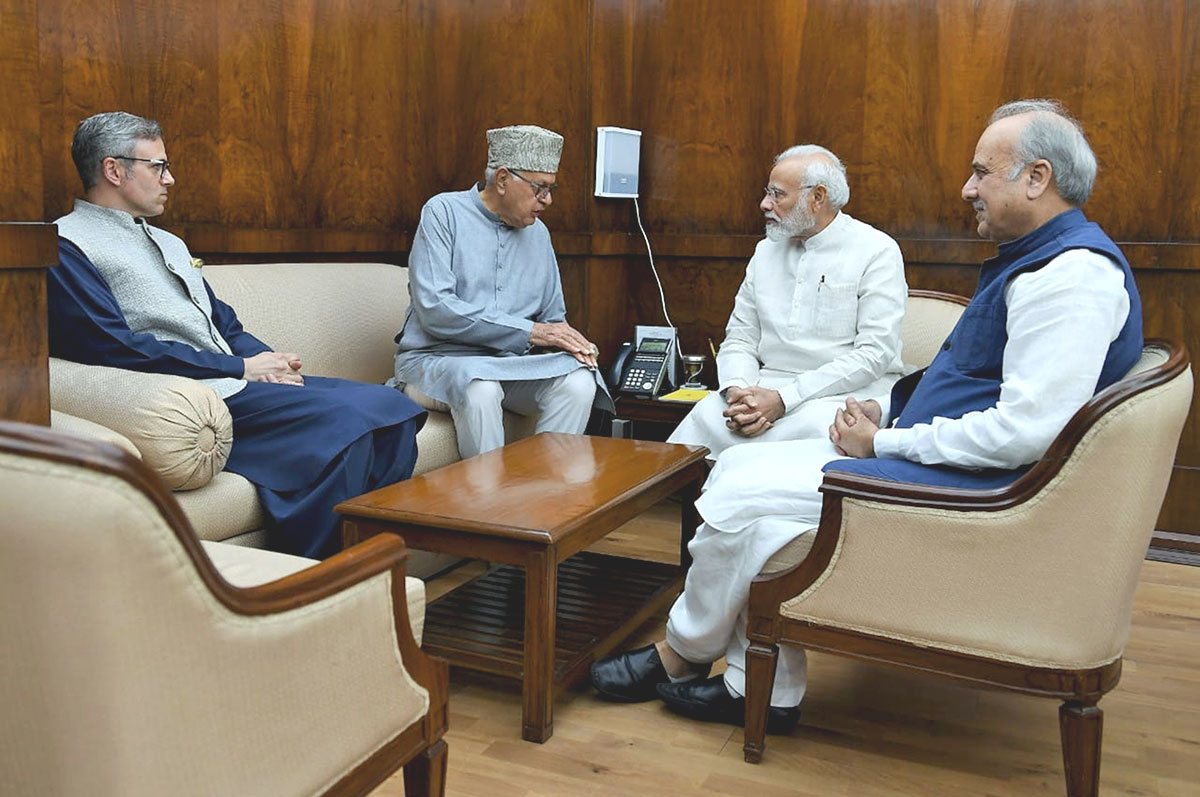
File photo of Dr Farooq Abdullah, Omar Abdullah and Justice Hasnian Masoodi with PM Narendra Modi in New Delhi.
It is possible that the abrogation of Kashmir’s entitlements and its bifurcation would be met with legal scrutiny. Some relevant — urgent — constitutional dilemmas must be addressed too. But the BJP’s biggest challenge would be to reaffirm its commitment to the compact between the State and its subjects in the troubled state. Both the end and the means of the ‘twin strikes’ have been questioned bitterly by Kashmir’s political parties and its people. Bridging this chasm is going to be more difficult than ‘integrating’ Kashmir with India.
It Is Time To Open Up Kashmir
The security imperative is important, but so are principles of liberty and humanity
The Hindustan Times
August 6, 2019
Kashmir has been locked up for three days. Movement is severely curtailed. Cable networks are off. Phone lines — both mobiles and landlines — are not operational. And internet services have been suspended. Leaders — including those who have no charges against them, and have pledged allegiance to the Indian constitution — are under detention. There is little information, except through official channels or sporadic satellite broadcasts, from the Valley about developments and the mood of the people.
The government took these steps in the run up to its landmark move in Parliament on Monday, to end the state’s special status and bifurcate Jammu and Kashmir. The security imperative was understandable. There were concerns that the announcement could trigger unrest. The valley’s security situation is vulnerable. Militants have often used times of political fragility and churn to spread disaffection and unleash violence. And the threat of Pakistan-based terrorists, or the Pakistan establishment, causing mischief is ever-present in the valley. The caution and preparations on the Indian side had a rationale to it.
But along with security, the Centre must also keep in mind the principles of liberty. and humanity. The civil liberties of Indian citizens in Kashmir today is severely curtailed. This has restricted their ability to live and work freely, or even manage essential supplies. It has also broken off links of Kashmiris outside the Valley with families back home, causing distress. It has affected those in the middle of medical emergencies, family events, including weddings, and affected all dimensions of life. With Eid around the corner, this is also meant to be a moment for families to come together. Except under extraordinary situations, it is important that the State actually enables citizens to live their lives freely. At a time like this, when there is understandable political anxiety in the Valley about its future, it is time for the Centre to lift restrictions, open up communication links, allow Kashmiris to engage with each other inside and outside, and express their views — while keeping up the security vigil.
Changing The Game In Kashmir
In nullifying Article 370 and bifurcating state, government has redrawn strategic calculus
The Times of India, Delhi
August 6, 2019
In a momentous decision, government moved Parliament yesterday to abate Article 370 of the Constitution and supersede Article 35A, thereby effectively ceasing the special status for Jammu & Kashmir. Simultaneously, Union home minister Amit Shah introduced the Jammu and Kashmir Reorganisation Bill to bifurcate the state and create two separate Union territories – Jammu & Kashmir with a legislature, and Ladakh without a legislature. This means that the Constitution of India shall now apply in full force across J&K and Ladakh, and the J&K legislature will henceforth not have any discretionary powers to decide who permanent residents of the territory are or provide them with special rights with respect to employment and acquisition of property.
Abrogating Article 370 has been a long-held wish of BJP which sees the provision as a historical wrong. However, the complicated history of Kashmir and the sensitivity surrounding the matter had hitherto prevented such a move. But with the current BJP government projecting muscular nationalism and enjoying significant numerical strength in Parliament, cessation of Article 370 became more doable. Given that abrogating Article 370 was part of the BJP manifesto, on the basis of which it swept Lok Sabha polls, the government has the mandate to do this. That non-NDA parties like BSP, AAP, YSRCP, BJD and AIADMK too have come out in support of the government’s move shows which way the winds are blowing.
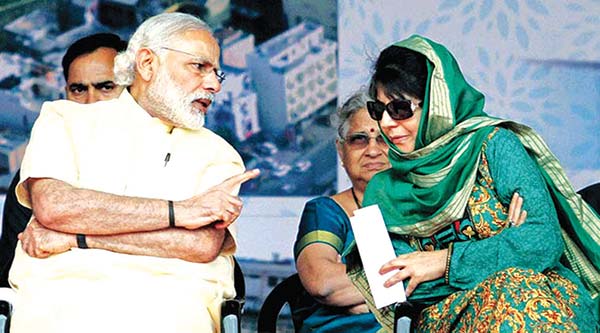
Prime Minister Narendra Modi with Mehbooba Mufti in April 2016
Arguably, Article 370 had contributed to the problems in Kashmir. The state’s special powers of autonomy meant in practice arrogation of power by a tiny Valley elite, which led to a feeling of not being represented among the people of Jammu and Ladakh, as well as disaffection feeding into separatist sentiment in the Valley itself. And given that Kashmir came to be a troubled state with separatist sentiments being stoked by Pakistan with the help of cross-border terrorism, this may have been the worst of both worlds. Besides, Article 370 was meant to be a temporary provision. In that sense its cessation now is congruent with historical constitutional perspective.
That said, there are some issues with the way in which Article 370 is being nullified and the state bifurcated. Even according to the constitutional provision to abate Article 370, consultation with the J&K state assembly is deemed necessary before a constitutional order to this effect is passed. The government, however, has chosen to use the fact that there is no J&K government at the moment and substituted the latter with the J&K governor. While this approach may or may not be legally valid, it certainly bypasses wider discussion on the matter that would have been democratically sound.
Second, the logic behind converting the state into two Union territories is also not plain. True, there has been a demand for Union territory status in Ladakh for some time. But with the cessation of Article 370, the special powers accruing to the J&K assembly in Srinagar would also extinguish. Thus, it is debatable if bifurcation of the state and creation of the Union territory of Ladakh was necessary after that.
In fact, this would be the first time in the history of India that a state was being converted into Union territories – the trend has been the other way around. Hence, given the magnitude of the decision, more all-round discussion would have been prudent. But perhaps government’s decision to push ahead with its Article 370 move was linked to external factors. With the US looking to wind down its military engagement in Afghanistan and turning to Pakistan to facilitate a peace deal with Afghan Taliban, Islamabad has been upping the ante on Kashmir.
New Delhi perhaps felt that Islamabad was gaining too much leverage in the emerging regional scenario and had to do something to counter this. Whatever the compulsions, even if Article 370 is abrogated New Delhi will have to – sooner rather than later – grant full statehood rights to Jammu & Kashmir and perhaps Ladakh too, for the sake of democratic governance as well as the federal principles in which India is grounded.
Shaking Up The Strategic Board
Government’s Kashmir move helps counter emerging regional situation
The Times of India
August 6, 2019
The ramifications of government’s blockbuster Kashmir move will certainly be debated for days to come. But one thing that is clear is that the move changes the terms of engagement with Pakistan. The latter was upping the ante vis-a-vis Kashmir in recent days, confident that it had got the US exactly where it wanted.
Washington, keen on withdrawing from Afghanistan and looking to hammer out a peace deal with the Afghan Taliban as early as September, was looking to Islamabad to facilitate the process. This was emboldening Islamabad which had raised the issue of American mediation in Kashmir, a bait that Donald Trump was willing to take.
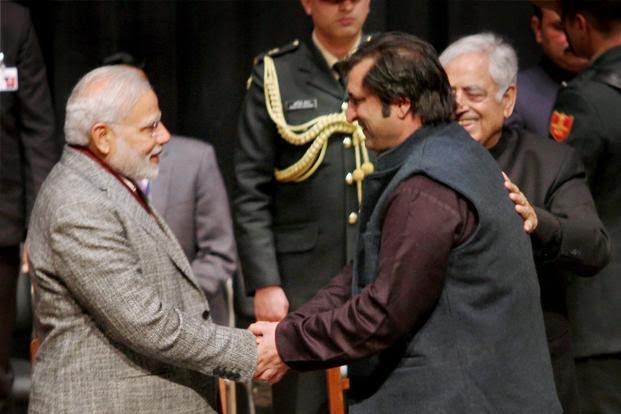
Sajad Gani Lone after taking the oath of office as a minister in Mufti Sayeed led government in 2015. KL Image
But by nullifying Article 370 that gave special status to Kashmir and creating two new Union territories of J&K and Ladakh, India seized back the momentum and effectively ended the disputed status of Kashmir. This will also change New Delhi’s equation with Islamabad. The latter has always raised Kashmir as a core issue in bilateral engagements. That, New Delhi will point out, is no longer necessary. In fact, India can now fully highlight cross-border terrorism sponsored by Pakistan as the key regional problem.
That said, what the latest changes mean for India’s claim on PoK remains to be seen. Technically, India will still claim the areas occupied by Pakistan and China. But having divided Kashmir further and bringing the resultant areas under greater Central control, India’s claims on PoK and Aksai Chin get diluted. But that’s a strategic fight for another day.
New Delhi, Old Line
Once again government at Centre sends message to Valley: It alone will decide, give no explanations.
The Indian Express, Delhi
August 5, 2019
Most astonishing of all was the abrupt cancellation of the Amarnath Yatra, citing a terrorist threat emanating from Pakistan, and the swift evacuation of tourists and pilgrims from the Valley.
What has unfolded over the last few days in Kashmir flies in the face of the claims by the NDA government, and Prime Minister Narendra Modi himself, of winning over Kashmir with love, dialogue and good governance. It is the government’s responsibility to reassure the people in times of crisis. But on full display since August 2 is exactly the opposite. Through a series of orders, some of them half-denied, and some implemented despite denials — the evacuation of NIT students, for example — the government has contributed to the spread of panic and uncertainty in the Valley and in the minds of other Indians, almost as if this was the intention. Most astonishing of all was the abrupt cancellation of the Amarnath Yatra, citing a terrorist threat emanating from Pakistan, and the swift evacuation of tourists and pilgrims from the Valley. Callously, the order asking them to leave immediately did not address the apprehensions of the people of Kashmir, thus conveying the crude and brute message that the government was not concerned about them, even as they rushed to petrol pumps and ATMs to stock up. Only weeks earlier, officials had been eager to project the situation in the Valley and at the LoC as much improved, with cross-border infiltration having come down drastically. The U-turn may be based on fresh information, and it is true that the Centre must have the room to take decisions for reasons not always in full public view, but calling off the pilgrimage to Amarnath is virtually an admission that the government cannot prevent terrorist attacks. This, despite the security presence in the Valley, and a new and technologically advanced security deployment specially designed for the pilgrimage.
Over the years, the yatra has become synonymous with the Centre’s assertion and demonstration of control over Kashmir. But here is a government that sends in more troops to the Valley, but at the same time, sends out the message that even with close to 4,50,000 troops there, it cannot offer security to pilgrims. In the absence of credible information, all manner of rumours — that plans are afoot to trifurcate J&K, or do away with the state’s special constitutional status, among others — have spread. The silence of the government and the top echelons of the party has been conspicuous, especially given that its leaders communicate ceaselessly on social media on other matters.
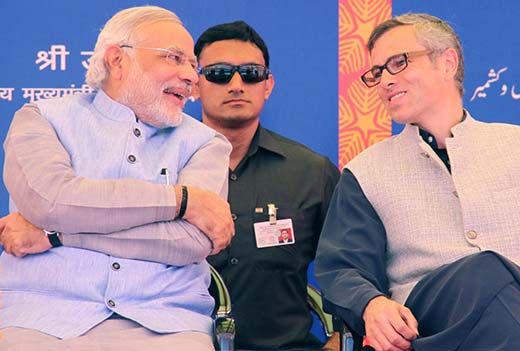
Whatever lies behind the government’s decisions of the last few days — whether it is preparation for contentious and polarising constitutional change, or a strategic assertion of statehood in response to the cosying up of the US with Pakistan towards a deal with the Taliban in Afghanistan — the fallout in the Valley cannot be good. That the government has chosen not to offer any explanations even to the leadership of the two main parties, who command a following among Kashmiris in their own right, is a mistake. Showing separatist politicians their place is one thing. But making a show of contempt for mainstream politicians is ill-judged. Any gains New Delhi has made in the past in the Valley have depended heavily on widening the stakes in peace and increasing the number of stakeholders. Now, an unfortunate impression is gaining ground that the Centre is again narrowing and centralising the decision-making process. Without the support of the Kashmiri people, Delhi’s disconnect with the Valley can only increase.
Scroll the Debate here
The post How The Media Commented Upon Art 370 Abrogation In 2019? appeared first on Kashmir Life.
from Kashmir Life https://ift.tt/3gwucie
via IFTTThttps://kashmirlife.net
No comments:
Post a Comment